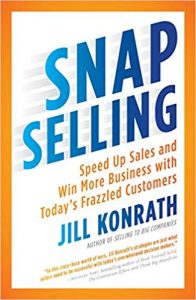Guest post by Jill Konrath
The following tips are excerpted with permission from Jill Konrath’s The Ultimate Guide to Email Prospecting.
According to email provider ExactTarget, people take only 2.7 seconds to decide if they will read, forward or delete a message. These busy people sit with their finger on the delete button ready to blast you into oblivion the moment they detect that you’re trying to sell them something.

How to Capture Attention
So what does it take to capture their attention? Is it even possible to craft an irresistible message that compels potential prospects to immediately hit “Reply” and request a meeting with you?
One seller sent an email to the CEO of a company and just eight minutes later got a return message asking for a conference call.
Another salesperson had been trying unsuccessfully to reach a decision maker for months. When she changed her messaging, she got a request for a meeting 30 minutes later.
An inside salesperson used these strategies to set up meetings with marketing VPs. While his competitors were battling it out in purchasing, he’d get the business with no competition.
Snap Factors Matter
What’s behind these lightning-quick decisions? I spent several years studying this behavior before I wrote Snap Selling, my newest book that’s focused on selling to frazzled people. I discovered that they evaluated every sales interaction (phone calls, emails, meetings) by asking themselves these four key questions.
How simple is it? In other words, does it require effort for me to quickly grasp the meaning or will it throw me into overload?
Does this person bring value? Yes, they’re making a decision about YOU personally. Not your company, service or solution. You!
Is this aligned with my objectives? Unless what you say is clearly aligned, it’s irrelevant and not worth even one more second of their valuable time.
How big a priority is it? Urgent matters always take precedence over everything else.
Mastering the Basics
Here are the primary things you need to think about before you even craft your message.
Length. Keep your prospecting emails under 90 words. Shorter is nearly always better when dealing with today’s crazy-busy prospects. Remember that many people are reading your messages in their preview screen or mobile device. They hate scrolling and worse, they hate rambling messages.
Look. Simple text (black and white) messages are essential when reaching out to a new person. If you have fancy templates, save them for your friends or family. They don’t evoke the image of a highly capable resource. Also, think carefully before using logos, and definitely avoid using colored fonts. Logos and color, especially red, catch the eye of spam blockers.
Links. If you have some good resources on your website that you want to drive your prospects to, only send one link per email. People will look at one link, but more than that sends them into overwhelm. Future emails can include the additional links.
Attachments. Don’t send any with your first email. People are wary of opening attachments from strangers. But after you’ve initiated a conversation (either online or via phone), it’s okay to send an attachment. Again, just send one at a time. If you send more, they won’t read any.
Proofing. Read your emails three times. Then print your email and read it again. You’ll be surprised at how different it looks, and you’ll catch overlooked errors. Spelling and obvious grammar errors give prospects the opportunity they’re looking for to hit the delete key.

About the Author
If you liked the ideas in this above post, check out Jill Konrath’s Prospecting Tool Kit that contains four free must-have sales tools. They’ll help you open more doors and ultimately close more sales. Download the Prospecting Tool Kit now: http://bit.ly/ProspectingKit.
For more about Jill Konrath and her book, click here Snap Selling.


Pingback: Book Marketing Makeover Months Redux | Book Marketing Bestsellers